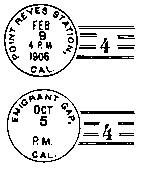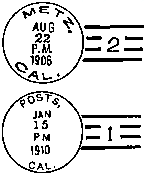


Doane Cancels were the Post Office Departments first attempt to improve postmark legibility by issuing rubber handstamps. The name honors Edith R. Doane a Postal Historian who became interested in these early 20th Century Handstamps in the 1950's. She published her first research findings in 1978.
The first 500 Type 1 experimental Doanes were issued in the first half of 1903. They were very successful and led to the permanent adoption ot this type of postmarking supplies for the smaller 4th class post offices, including the possessions. Most of these were issued to Post Offices where the reciepts did not exceed $500 in a year. They were issued to both new and existing Post Offices requesting new supplies. Some were issued to larger 2nd and 3rd class Post Offices when requested by their Postmasters.
Type 1 Doane Cancels have 5 bars with a number in them. They were issued from Aug. 28, 1903 to Sep. 28, 1903 for just one month. Approximately 1600 Type 1 Doane Handstamps were issued including the 500 Experimental Post offices.
Type 2 Doane Cancels have 2 sets of railroad track type bars with a number in them. They were issued from Sep. 29, 1903 until Jun. 30, 1905. Approximately 17,500 Type 2 Doane Handstamps were issued.
Type 3 Doane Cancels have 4 solid bars like a standard 4-bar handstamp cancel with a number in them. Sometimes they are very hard to see because of the green colored stamps of the period. They were issued from Jul. 1, 1905 until the fall of 1906. Approximately 12,000 Type 3 Doane handstamps were issued.
Shown below are the 3 Types of Doanes



Type 1 Doane Type 2 Doane Type 3 Doane
The number in the bars of all 3 types refers to Postmaster compensation in the previous fiscal year. A "1" in the bars meant the Postmaster compensation for the year was less than $100, a "2" in the bars meant Postmaster compensation was between $100 and $200 for the year and for each additional $100 increment the number was increased by 1. The highest number seen by me so far is a Type 3 Doane with the number "22" used by Naperville, Ill.
Some of these devices became worn or damaged with use and improper handling. Some of them became so distorted, dirty or had the killer bars replaced that it is sometimes hard to tell if they are doanes. Most were used for anywhere from 1-10 years. A few Postmasters took very good care of their cancelling devices and you can find them being used in the 1930's, 1940's and 1950's.
An * by any Post Office name on a Doane list means that by the date of establishment of this office that it should have had a Doane issued to it. The Type and Number predicted are in parentheses. These are only predictions based on this information and no Doanes have been recorded from these Post Offices.
Any post office that has an NS in the Type column is a Doane Mimic. I am going to try and do this throughout the lists where there is not a doane footnote to confirm this.
![]()
Colorado Doane List - Charles Boubelik Coordinator - Email Gary
Connecticut Doane List - Ralph Edson Coordinator Email Gary
Indian Territory Doane List - Joe Crosby Coordinator Email Joe
Maine Doane List - Gary Anderson Coordinator Email Gary
Michigan Doane List - Gary Anderson Coordinator Email Gary
New Mexico Doane List - Dr. Thomas K. Todsen Coordinator Email Gary
Oklahoma Doane List - Joe Crosby Coordinator -Email Joe
Vermont Doane List - Bill Lizotte Coordinator Email Gary
Wyoming Doane List - Charles Boubelik Coordinator Email Gary
![]()